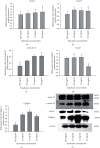Cinobufacini Inhibits the Development of Pancreatic Cancer Cells through the TGF β/Smads Pathway of Pancreatic Stellate Cells
- PMID: 35815263
- PMCID: PMC9262525
- DOI: 10.1155/2022/3719857
Cinobufacini Inhibits the Development of Pancreatic Cancer Cells through the TGF β/Smads Pathway of Pancreatic Stellate Cells
Retraction in
-
Retracted: Cinobufacini Inhibits the Development of Pancreatic Cancer Cells through the TGFβ/Smads Pathway of Pancreatic Stellate Cells.Evid Based Complement Alternat Med. 2023 Dec 13;2023:9843430. doi: 10.1155/2023/9843430. eCollection 2023. Evid Based Complement Alternat Med. 2023. PMID: 38125101 Free PMC article.
Abstract
This study aimed to test cinobufacini therapeutic potential for pancreatic cancer, verify its potential molecular mechanism, and evaluate the cinobufacini impact on pancreatic cancer microenvironment. First, the effect of cinobufacini-treated pancreatic stellate cells (PSCs) supernatant on the value-added ability of pancreatic cancer (PCCs) was tested. The results show that cinobufacini can effectively reduce the ability of PSCs supernatant to promote the value-added PCCs. Further results show that cinobufacini can effectively reduce the concentration of TGFβ in the supernatant of PSCs. Subsequently, the impact of cinobufacini on the transcription and translation levels of key genes in the TGFβ/Smads pathway was examined. The results showed that the impact of cinobufacini on the transcription levels of Smad2, Smad3, and Smad7 was in a concentration-dependent manner, while the transcriptional activity of collagen I mRNA was decreased with the increase of cinobufacini concentration. The results of protein expression showed that cinobufacini could upregulate the expression of inhibitory protein Smad7, inhibit the phosphorylation level of p-Smad2/3, and then suppress the expression of type I collagen (collagen I). On the one hand, this study shows that cinobufacini can inhibit the promotion of PSCs on the proliferation of PCCs. On the other hand, cinobufacini can upregulate the expression of the inhibitory molecule, Smad7, through the TGFβ/Smads pathway and reduce the phosphorylation level of p-Smad2/3, thereby inhibiting the expression of collagen I and pancreatic fibrosis. cinobufacin can inhibit the proliferation of SW1900 cells by blocking the TGFβ/Smads pathway of pancreatic stellate cells. These results provide a clinical basis for the treatment of pancreatic cancer.
Copyright © 2022 Quan-Wang Li et al.
Conflict of interest statement
The authors declare that they have no conflicts of interest.
Figures




Similar articles
-
Retracted: Cinobufacini Inhibits the Development of Pancreatic Cancer Cells through the TGFβ/Smads Pathway of Pancreatic Stellate Cells.Evid Based Complement Alternat Med. 2023 Dec 13;2023:9843430. doi: 10.1155/2023/9843430. eCollection 2023. Evid Based Complement Alternat Med. 2023. PMID: 38125101 Free PMC article.
-
The TGFβ-SMAD3 pathway inhibits IL-1α induced interactions between human pancreatic stellate cells and pancreatic carcinoma cells and restricts cancer cell migration.J Exp Clin Cancer Res. 2016 Jul 29;35(1):122. doi: 10.1186/s13046-016-0400-5. J Exp Clin Cancer Res. 2016. PMID: 27473228 Free PMC article.
-
Inhibitory Smads suppress pancreatic stellate cell activation through negative feedback in chronic pancreatitis.Ann Transl Med. 2021 Mar;9(5):384. doi: 10.21037/atm-20-4282. Ann Transl Med. 2021. PMID: 33842605 Free PMC article.
-
Molecular Mechanism of Pancreatic Stellate Cells Activation in Chronic Pancreatitis and Pancreatic Cancer.J Cancer. 2020 Jan 14;11(6):1505-1515. doi: 10.7150/jca.38616. eCollection 2020. J Cancer. 2020. PMID: 32047557 Free PMC article. Review.
-
Pancreatic Stellate Cells: The Key Orchestrator of The Pancreatic Tumor Microenvironment.Adv Exp Med Biol. 2020;1234:57-70. doi: 10.1007/978-3-030-37184-5_5. Adv Exp Med Biol. 2020. PMID: 32040855 Review.
Cited by
-
Cinobufacini injection suppresses the proliferation of human osteosarcoma cells by inhibiting PIN1-YAP/TAZ signaling pathway.Front Pharmacol. 2023 Mar 17;14:1081363. doi: 10.3389/fphar.2023.1081363. eCollection 2023. Front Pharmacol. 2023. PMID: 37006999 Free PMC article.
-
Chemical Composition, Pharmacological Effects and Clinical Applications of Cinobufacini.Chin J Integr Med. 2024 Apr;30(4):366-378. doi: 10.1007/s11655-024-3708-6. Epub 2024 Jan 12. Chin J Integr Med. 2024. PMID: 38212503 Review.
-
Retracted: Cinobufacini Inhibits the Development of Pancreatic Cancer Cells through the TGFβ/Smads Pathway of Pancreatic Stellate Cells.Evid Based Complement Alternat Med. 2023 Dec 13;2023:9843430. doi: 10.1155/2023/9843430. eCollection 2023. Evid Based Complement Alternat Med. 2023. PMID: 38125101 Free PMC article.
References
-
- Tjomsland V., Sandnes D., Pomianowska E., et al. The TGFβ-SMAD3 pathway inhibits IL-1α induced interactions between human pancreatic stellate cells and pancreatic carcinoma cells and restricts cancer cell migration. Journal of Experimental & Clinical Cancer Research . 2016;35(1):p. 122. doi: 10.1186/s13046-016-0400-5. - DOI - PMC - PubMed
Publication types
LinkOut - more resources
Full Text Sources

